Enrichment Geological Conditions and Resource Evaluation Methods for the Gas in Thinly Interbedded Coal Measures: A Case Study of the Chengzihe Formation in the Jixi Basin
Abstract
1. Introduction
2. Geological Setting
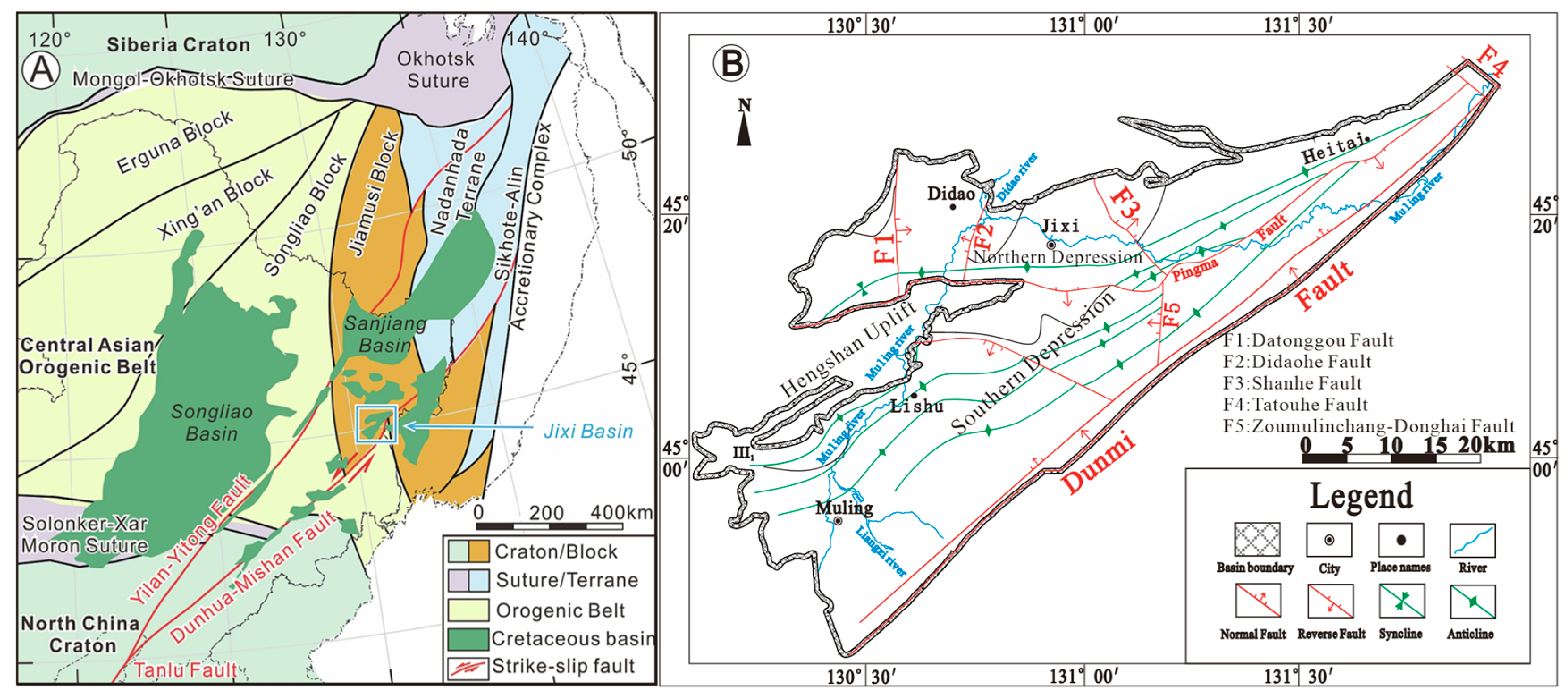
3. Methodology
3.1. Resource Evaluation Method
3.2. Parameter Acquisition
3.2.1. Gas-Bearing Area
3.2.2. Gas Content
3.2.3. Density
3.2.4. Thickness
4. Results and Discussion
4.1. Geological Conditions for the Development of Thinly Interbedded Coal Measure Gas Reservoirs
4.1.1. Geological Conditions of Thinly Interbedded Coal Measures
4.1.2. Symbiotic Combination Mode of Thinly Interbedded Coal Measure Gas
4.2. Gas Enrichment Characteristics and Control Factors of Thinly Interbedded Coal Measure
4.2.1. Gas Content and Thickness of Thin Interbeds
4.2.2. Controlling Factors
4.3. Resource Evaluation Results
5. Conclusions
Author Contributions
Funding
Data Availability Statement
Acknowledgments
Conflicts of Interest
References
- Sun, Q.; Zhao, Q.; Jiang, X.; Zhang, J.; Liu, Y.; Wang, C.; Liu, Q. Prospects and strategies of CBM exploration and development in China under the new situation. J. China Coal Soc. 2021, 46, 65–76. [Google Scholar]
- Zhu, Q.; Yang, Y.; Zuo, Y.; Wang, H.; Zhang, T. On the scientific exploitation of high-rank CBM resources. Nat. Gas Ind. 2020, 40, 55–60. [Google Scholar] [CrossRef]
- Zhang, G.; Li, Z.; Lan, L.; Zhao, S.; Liu, J. Natural gas in large gas fields in the South China Sea is mainly coal-type gas. Nat. Gas Ind. 2021, 41, 12–23. [Google Scholar]
- Wang, W.; Zhang, H.; Shi, Y.; Fu, X.; Hui, J.; Jing, X. Geological characteristics and exploration potential of the coal measure gas from Shan 2 of the Shanxi Formation in the eastern Ordos Basin. Front. Earth Sci. 2023, 11, 1142141. [Google Scholar]
- Shao, Y.; Wang, H.; Guo, Y.; Huang, X.; Wang, Y.; Zhao, S.; Zhu, Y.; Shen, L.; Huang, X.; Song, Y.; et al. Geological characteristics and gas-bearing evaluation of coal-measure gas reservoirs in the Huanghebei Coalfield. Front. Earth Sci. 2023, 11, 1104418. [Google Scholar] [CrossRef]
- Wang, Y.; Qin, Y.; Yang, L.; Liu, S.; Elsworth, D.; Zhang, R. Organic geochemical and petrographic characteristics of the coal measure source rocks of Pinghu Formation in the Xihu Sag of the East China Sea Shelf Basin: Implications for coal measure gas potential. Acta Geol. Sin.-Engl. Ed. 2020, 94, 364–375. [Google Scholar] [CrossRef]
- Li, L.; Ma, S.; Liu, X.; Liu, J.; Lu, Y.; Zhao, P.; Kassabi, N.; Hamdi, E.; Elsworth, D. Coal Measure Gas Resources Matter in China: Review, Challenges, and Perspective. Phys. Fluids 2024, 36, 071301. [Google Scholar] [CrossRef]
- Yang, S.; Li, S.; Tian, W.; Zhong, G.; Wang, J. Sequence stratigraphic analysis of superimposed coal measure gas-bearing system in Daning-Jixian Block, eastern margin of Ordos Basin, China. Front. Earth Sci. 2024, 18, 611–622. [Google Scholar] [CrossRef]
- Tian, W.; Zhao, S.; Tian, F.; Li, X.; Huo, W.; Zhong, G.; Li, S. Symbiotic combination and accumulation of coal measure gas in the Daning-Jixian Block, eastern margin of Ordos Basin, China. Energies 2023, 16, 1737. [Google Scholar] [CrossRef]
- Tao, S.; Chen, S.D.; Pan, Z. Current status, challenges, and policy suggestions for coalbed methane industry development in China: A review. Energy Sci. Eng. 2019, 7, 1059–1074. [Google Scholar] [CrossRef]
- Zhang, B.; Tao, S.; Sun, B.; Tang, S.L.; Chen, S.D.; Wen, Y.J.; Ye, J.C. Genesis and accumulation mechanism of external gas in deep coal seams of the Baijiahai Uplift, Junggar Basin, China. Int. J. Coal Geol. 2024, 286, 104506. [Google Scholar] [CrossRef]
- Tao, S.; Pan, Z.; Tang, S.; Chen, S. Current status and geological conditions for the applicability of CBM drilling technologies in China: A review. Int. J. Coal Geol. 2019, 202, 95–108. [Google Scholar] [CrossRef]
- Qin, Y.; Moore, T.A.; Shen, J.; Yang, Z.; Shen, Y.; Wang, G. Resources and geology of coalbed methane in China: A review. In Coal Geology of China; Routledge: London, UK, 2020; pp. 247–282. [Google Scholar]
- Zou, C.; Yang, Z.; Huang, S.; Ma, F.; Sun, Q.; Li, F.; Pan, S.; Tian, W. Resource types, formation, distribution and prospects of coal-measure gas. Pet. Explor. Dev. 2019, 46, 451–462. [Google Scholar] [CrossRef]
- Chen, S.; Tao, S.; Tang, D. In situ coal permeability and favorable development methods for coalbed methane (CBM) extraction in China: From real data. Int. J. Coal Geol. 2024, 284, 104472. [Google Scholar] [CrossRef]
- Qin, Y. Thinking and discussion for some problems of geological survey of coal measures gas. Geol. China 2023, 50, 1355–1374. [Google Scholar]
- Li, Y.H.; Ni, X.M.; Wang, B.Y.; Zhao, J.C. Estimation of coal measure gas resources and prediction of favorable development intervals in eastern Pingdingshan mining area. Daqing Pet. Geol. Dev. 2025, 44, 147–155. [Google Scholar]
- Bi, C.Q.; Hu, Z.F.; Tang, D.Z.; Tao, S.; Zhang, J.Q.; Tang, S.L.; Huang, H.Z.; Tang, Y.; Yuan, Y.; Xu, Y.B.; et al. Research progress of coal measure gas and some important scientific problems. Geol. China 2021, 48, 402–423. [Google Scholar]
- Zhang, J.Q.; Bi, C.Q.; Xu, Y.B.; Tong, L.H.; Tang, Y.; Yuan, Y.; Pang, S.J.; Zhou, J.L. Progresses and main achievements on unconventional oil and gas geological survey project. Geol. Surv. China 2023, 1, 1–19. [Google Scholar]
- Li, L. Calculation of coalbed methane reserves and economic evaluation of Lishu Coal Mine in Jixi Basin. Coal Sci. Technol. 2017, 45, 205–210. [Google Scholar]
- Li, H.; Cao, D.Y.; Yao, Z.; Tan, J.Q. Structural features and coal-controlling structure analysis in Jixi Basin. Coal Geol. China 2012, 24, 10–13+23. [Google Scholar]
- Cao, C.R.; Zhang, D.K.; Bai, L.A.; Zhang, Y.J. Tectonic evolution and probability distribution of CBM resources in Jixi Basin. World Geol. 2009, 28, 498–502+525. [Google Scholar]
- Zhang, F.Q.; Dilek, Y.; Chen, H.L.; Yang, S.F.; Shu, S.F.; Meng, Q.A. Structural architecture and stratigraphic record of Late Mesozoic sedimentary basins in NE China: Tectonic archives of the Late Cretaceous continental margin evolution in East Asia. Earth Sci. Rev. 2017, 171, 593–620. [Google Scholar] [CrossRef]
- Liu, J.L.; Li, H.B.; Zhang, X.B.; Zhang, Y.F.; Shen, J.N.; Wang, J. Pore characteristics and controlling factors of coal reservoirs from Jixi Basin. Pet. Geol. Exp. 2018, 40, 691–698. [Google Scholar]
- Xu, S.L.; Xie, C.Q. Comparative study on coal reservoir characteristics of the north-south depression in the Jixi Basin. Coal Sci. Technol. 2023, 44, 70–80. [Google Scholar]
- Chen, D.X.; Tian, Y.T.; Wang, Z.N.; Zhao, X.Q. A marine transgressive cycle driven by the dynamics of the Paleo-Pacific subduction: Insights from structural architecture and kinematics of the Jixi Basin, NE China. J. Asian Earth Sci. 2023, 257, 105851. [Google Scholar] [CrossRef]
- GB/T 31483-2015; Proximate Analysis of Shale Gas. Geological Evaluation Method. Administration of Quality Supervision, Inspection and Quarantine of People’s Republic of China: Beijing, China, 2015. (In Chinese)
- DZ/T 0216-2020; Coalbed Methane Resources/Reserves Specification. China Standards Press: Beijing, China, 2020. (In Chinese)
- GB/T 30501-2022; Geological Evaluation Method of Tight Sandstone Gas. China Standards Press: Beijing, China, 2022. (In Chinese)
- Shen, Y.Y.; Ren, D.J.; Chang, S.L.; Zhang, S.; Liu, Z.L.; Liu, B.; Liu, J. Prediction of sedimentary facies before and after coal accumulation and its controlling effects in Block Yonglenan, Qinshui Basin. Sci. Technol. Eng. 2021, 21, 4352–4359. [Google Scholar]
- Chen, H. Study on Coupling Accumulation Mechanism and Favorable Area Prediction of Coal Measure Gas in Jixi Basin. Ph.D. Thesis, China University of Geosciences, Beijing, China, 2023. [Google Scholar]
- Hou, W.; Fan, T.L.; Wang, H.H.; Zhang, Y.Q.; Shen, W.X.; Wang, J.C. Controls of sedimentary microfacies on lithologic oil pools in the Changling Depression, southern Songliao Basin: An example from the Qingshankou Formation in the Yaoyingtai region. Sediment. Geol. Tethyan Geol. 2011, 31, 26–33. [Google Scholar]
- Sun, Y.T. Optimization of Production Layer Combination and Feasibility Study of Combined Mining of Coal Measure Gas Well in Jixi Basin. Master’s Thesis, China University of Mining and Technology, Xuzhou, China, 2022. [Google Scholar]
- Xi, Z.D.; Tang, S.H.; Yang, G.Q.; Li, L.; Gong, M.H.; Wang, K.Y.; Zhang, B.M. Accumulation and combination characteristics of coal measure gas of Shaoyang Depression in the central Hunan. J. China Coal Soc. 2018, 43, 1589–1597. [Google Scholar]
- Huai, Y.C.; Qu, L.C.; Zhang, M.; Xia, Z.H. Evaluation method of shale gas content based on logging data. Sci. Technol. Eng. 2017, 17, 33–38. [Google Scholar]
- Liu, F.; Ma, J.; Wu, K.; Li, S.P.; Zan, C.L.; Luo, L.R. Structural characteristics and origin of twisted traces in Longouanshan Tectonic Belt. Nat. Gas Explor. Dev. 2013, 36, 7–15. [Google Scholar]
- Cai, Y.D.; Liu, D.M.; Yao, Y.B.; Li, J.Q.; Guo, X.Q.; Zhang, B.R. Geological controlling factors and prospective areas of coalbed methane in the Jixi Basin. J. Jilin Univ. 2014, 44, 1779–1788. [Google Scholar]
- Zhang, Z.T.; Lin, C.S.; Li, H.Y.; Zhang, G.K.; Dai, J.L. Characteristics of the Cenozoic cap rock and its control on hydrocarbon in the western Bohai Sea area. J. Geomech. 2019, 25, 357–369. [Google Scholar]
- Zhou, X.F.; Zhang, Y.S.; Yan, D.T.; Tang, J.R.; Wu, Z.X.; Ma, Z.S.; Zhou, F. Quantitative evaluation of sealing capacity of Tertiary mudstone caprock in Lenghu area, Qaidam Basin. J. Earth Sci. 2018, 43, 226–233. [Google Scholar]
- Zhao, X.Y.; Wei, B.; Yuan, L.; Ge, Y.Y.; Hu, Y.; Li, X.; Wang, M.M.; Jia, C.; Mayila, A.I.S.; Tian, J.J. Hydrological characters of coal reservoir and their significance on coalbed methane development: A review. Int. J. Coal Sci. Technol. 2022, 105, 105–117. [Google Scholar]
- Li, J.; Che, Y.Q.; Xiong, X.Y.; Wang, W.; Li, T.; Wang, C.W.; Hu, H.Y. Hydrochemistry field characteristics of 11# coal seam in Hancheng CBM field and its controlling effect on CBM. China Pet. Explor. 2018, 23, 74–80. [Google Scholar]
- Xiong, L.; Kang, B.P.; Shi, H.L.; Jiang, W.; Wang, J. The chemical characteristics and its dynamic transportation of gasfield water of Dayi gas reservoir of Western Sichuan. J. Southwest Pet. Univ. 2011, 33, 84–88+194. [Google Scholar]
- Wei, M.M.; Ju, Y.W. Chemical characteristics and origin of produced waters from coalbed gas field in the southern of Qinshui Basin. J. China Coal Soc. 2015, 40, 629–635. [Google Scholar]
- Singh, A.K.; Singh, M.P.; Sharma, M.; Srivastava, S.K. Microstructures and microtextures of natural cokes: A case study of heat-affected coking coals from the Jharia coalfield, India. Int. J. Coal Geol. 2007, 71, 153–175. [Google Scholar] [CrossRef]
- Saghafi, A.; Pinetown, K.L.; Grobler, P.G.; van Heerden, J. CO₂ storage potential of South African coals and gas entrapment enhancement due to igneous intrusions. Int. J. Coal Geol. 2008, 73, 74–87. [Google Scholar] [CrossRef]
- Golab, A.N.; Carr, P.F. Changes in geochemistry and mineralogy of thermally altered coal, Upper Hunter Valley, Australia. Int. J. Coal Geol. 2004, 57, 197–210. [Google Scholar] [CrossRef]
- Jiang, J.Y.; Cheng, Y.P.; Wang, L.; Li, W.; Wang, L. Petrographic and geochemical effects of sill intrusions on coal and their implications for gas outbursts in the Wolonghu Mine, Huaibei Coalfield, China. Int. J. Coal Geol. 2011, 88, 55–66. [Google Scholar] [CrossRef]
- Yao, Y.; Liu, D. Effects of igneous intrusions on coal petrology, pore-fracture and coalbed methane characteristics in Hongyang, Handan and Huaibei coalfields, North China. Int. J. Coal Geol. 2012, 96, 72–81. [Google Scholar] [CrossRef]
- Yao, Y.; Liu, D.; Huang, W. Influences of igneous intrusions on coal rank, coal quality and adsorption capacity in Hongyang, Handan and Huaibei coalfields, North China. Int. J. Coal Geol. 2011, 88, 135–146. [Google Scholar] [CrossRef]
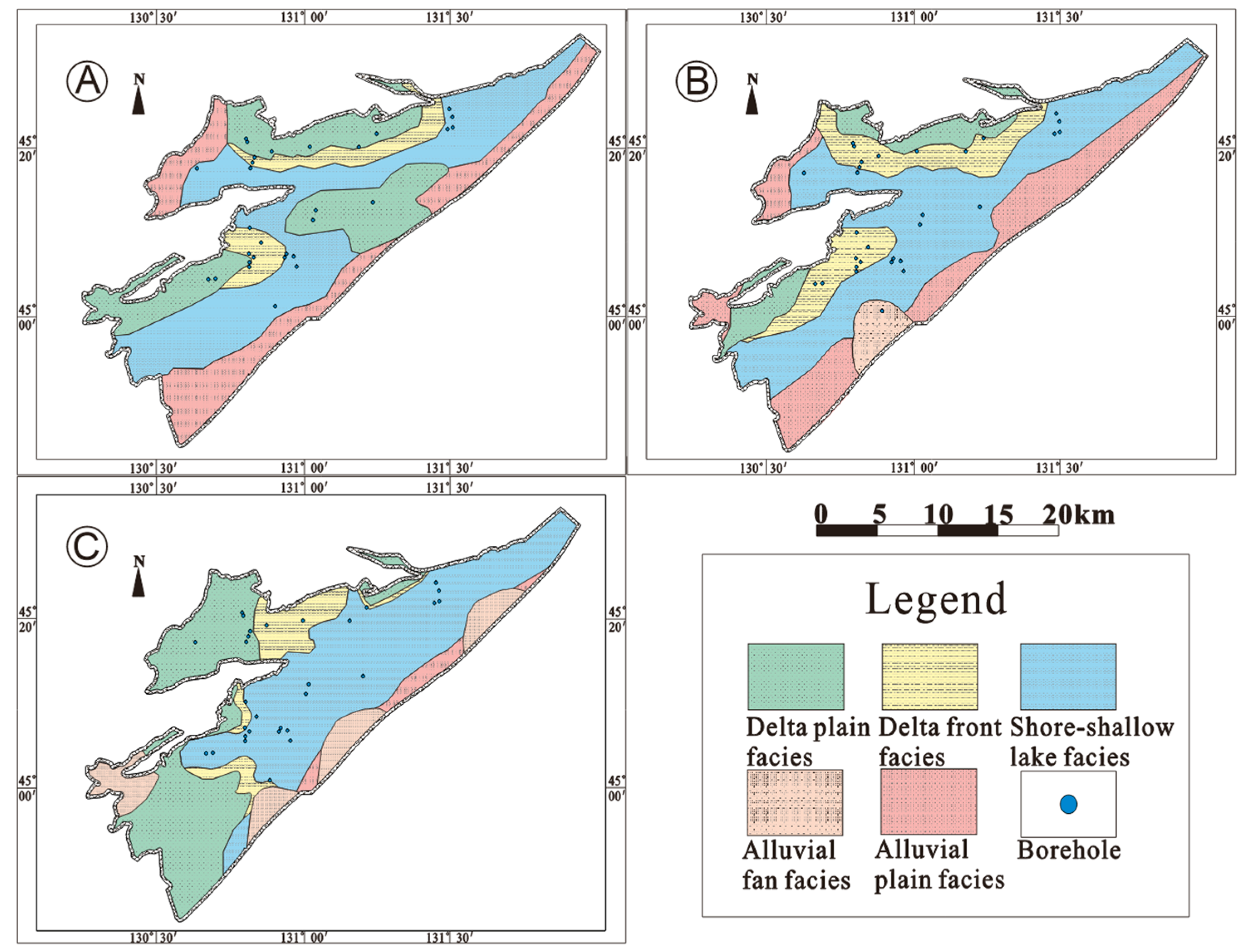
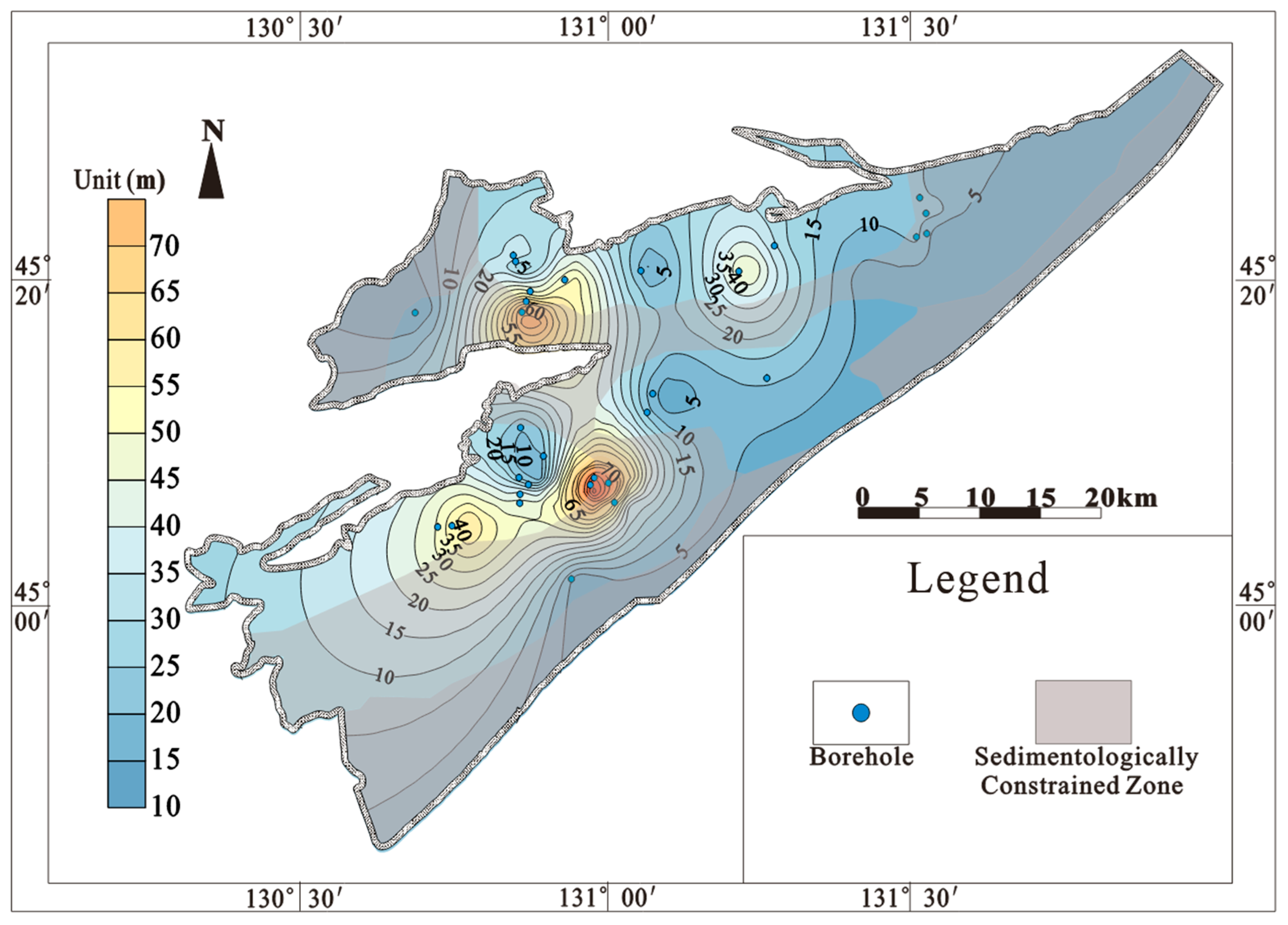
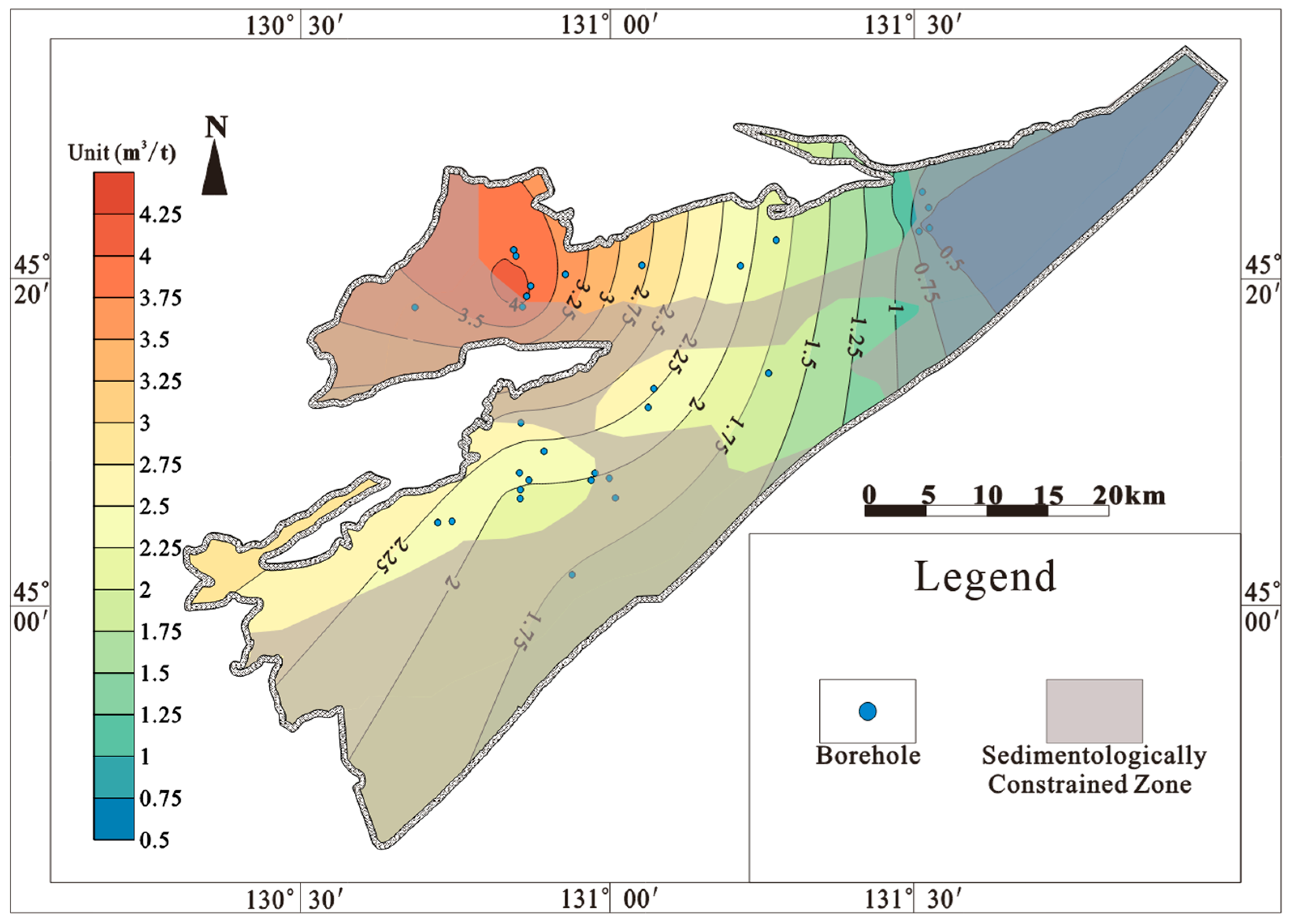
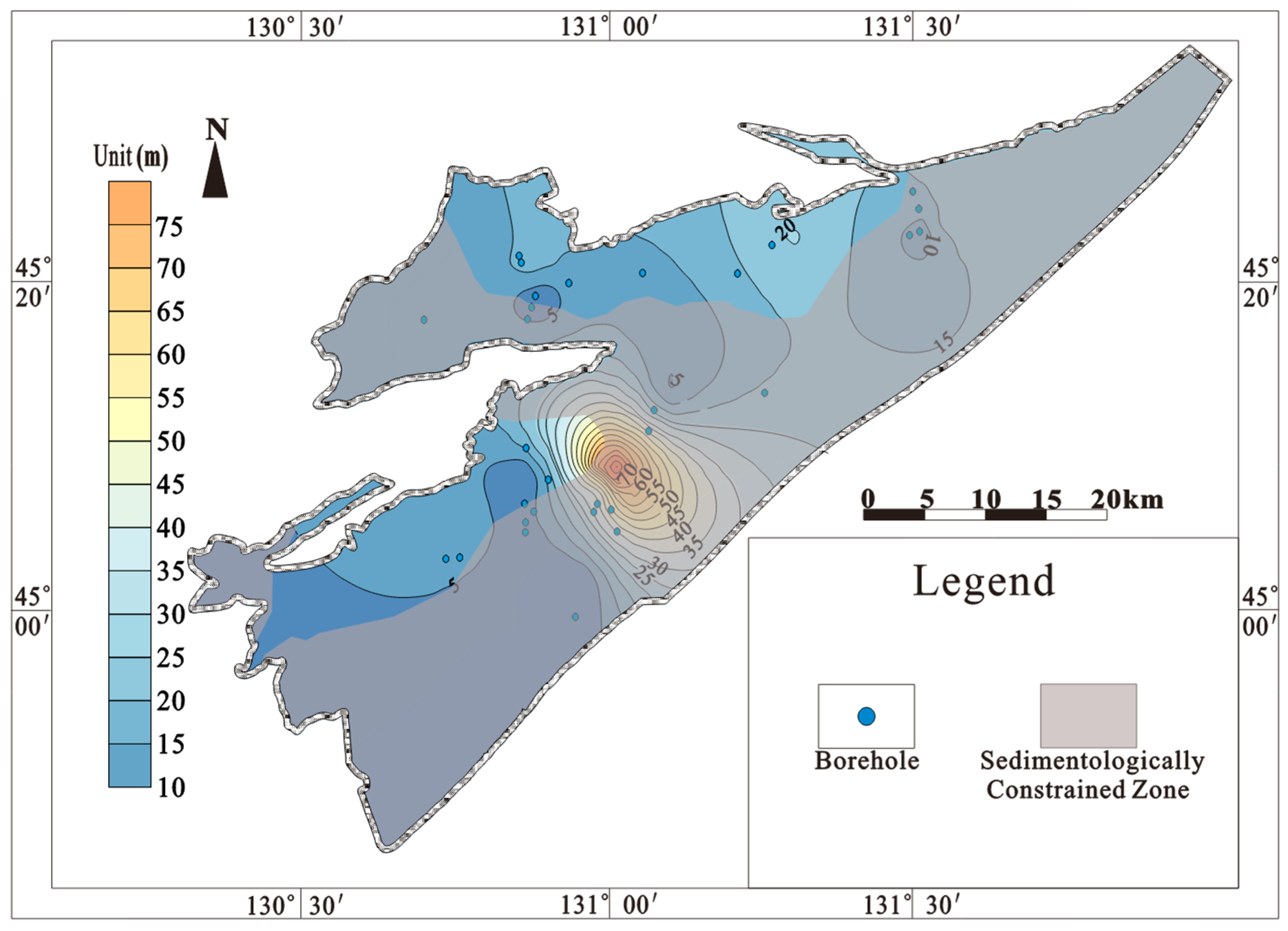
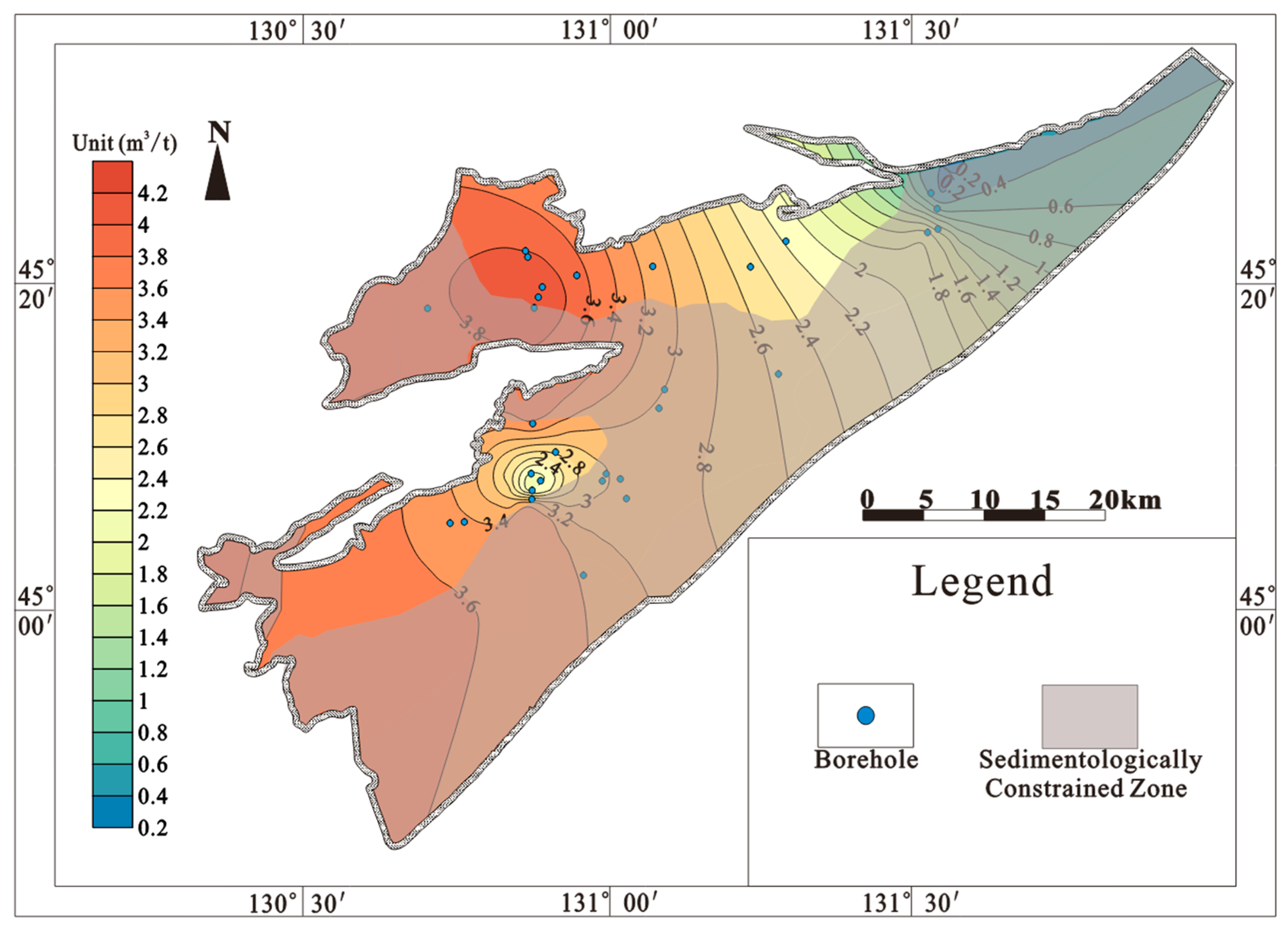
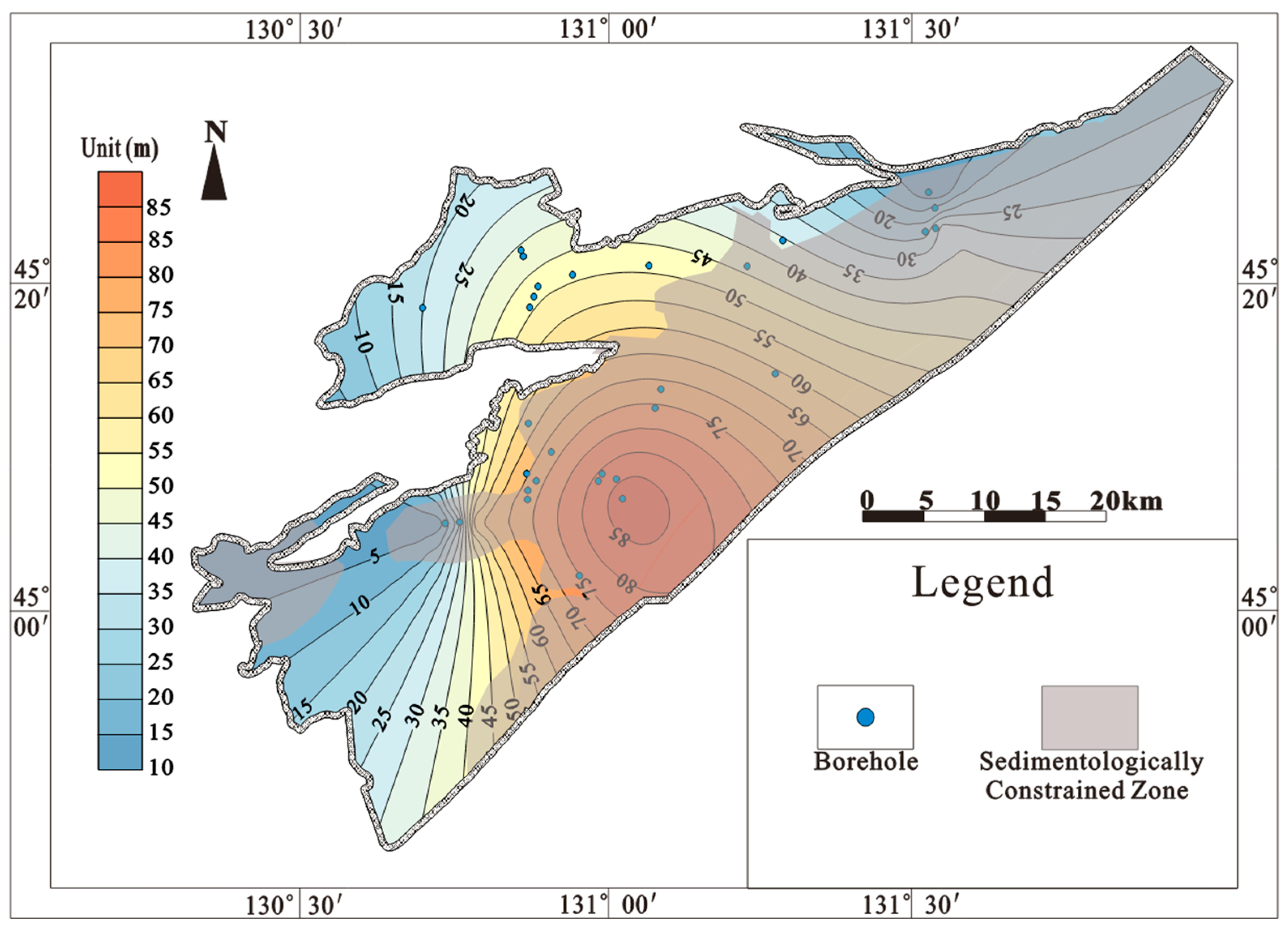
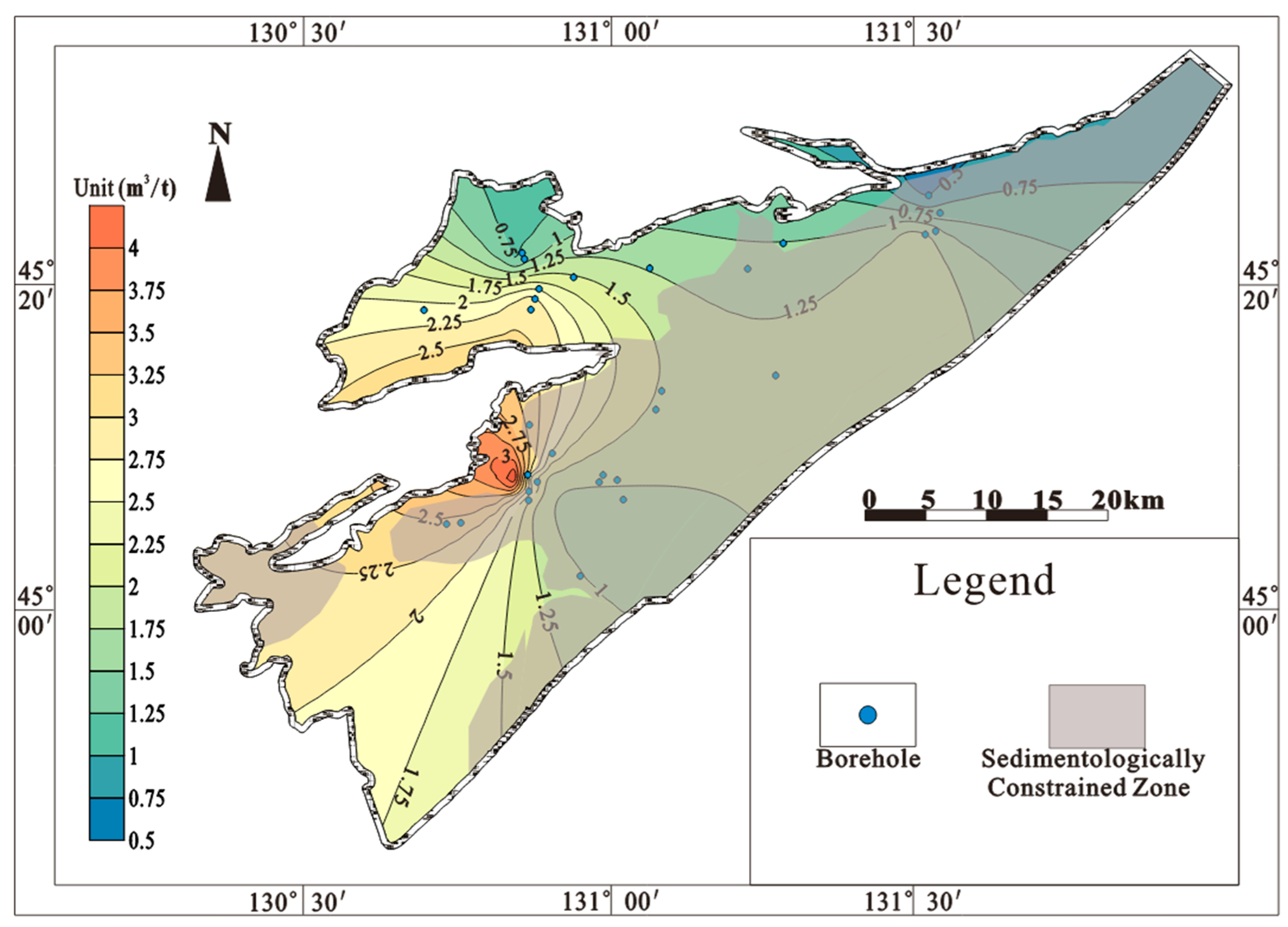
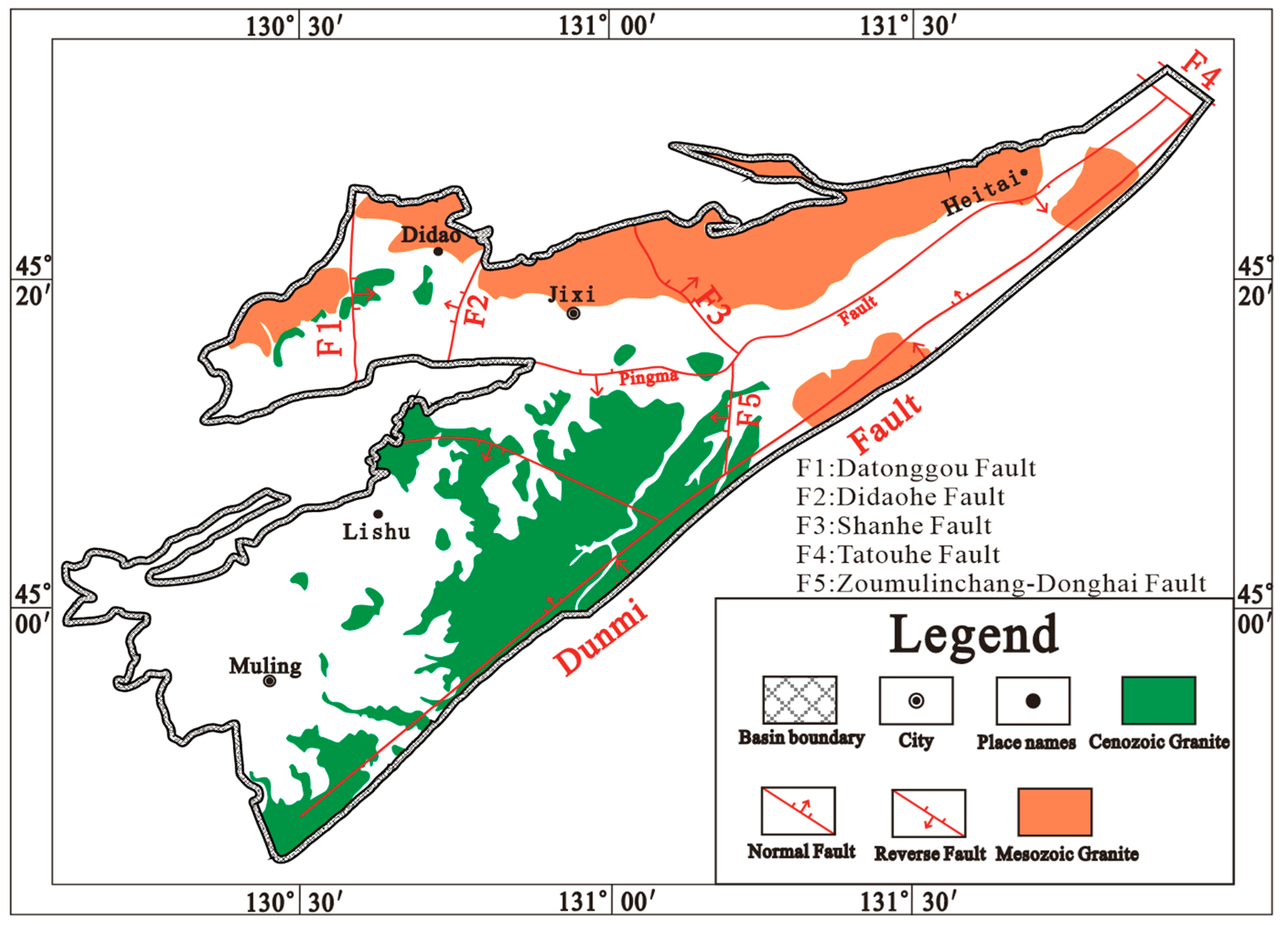
| Lithology | Gas Content Data Wells | Prediction Method |
|---|---|---|
| Coal | JMC1, JMC2, HJD1, HJD2, LS02-1V, LS02-2D, DD-05, ZK-29, ZK-30, ZK-50, PG17-1, ZK12-73, ZK12-82, ZK12-87, ZK12-93 | Multi-linear Regression Method |
| Mudstone | HJD2, JMC1 | Formula method |
| Sandstone | HJD2, JMC1, JMC2 | Formula method |
| Well Number | Logging Parameters | Multiple Linear Regression Model | R |
|---|---|---|---|
| JMC1 | GR, SP, CAL, RLLS, R | 0.87 | |
| JMC2 | DEN, AC, CNL, RLLS, QT, RLLD | 0.94 | |
| HJD1 | ρb, AC1, AC2, RLLD, SP | 0.86 | |
| HJD2 | ρb, AC, RLLS, RLLD, SP, CAL | 0.89 | |
| LS02-1V | GR, DEN, CNL | 0.95 | |
| LS02-2D | GR | 0.895 | |
| PG17-1 | CAL, GR | 0.864 | |
| ZK12-82 | GR, SP, R | 0.863 | |
| ZK12-87 | R, CAL | 0.853 | |
| ZK12-93 | GR, SP, CAL, R | 0.859 |
| Well Number | Multiple Linear Regression Model | R |
|---|---|---|
| J2 | 0.992 | |
| J6 | 0.86 | |
| JC1 | 0.986 | |
| JD2 | 0.87 | |
| JD6 | 0.852 | |
| JD7 | 0.907 | |
| JD8 | 0.892 | |
| JMC1 | 0.86 | |
| JMC2 | 0.992 | |
| HJD2 | 0.91 |
| Well Number | Multiple Linear Regression Model | R |
|---|---|---|
| JMC1, HJD2 | 0.875 |
| Well Number | Layer ID | Member | Thickness (m) | Average Density (g/cm3) |
|---|---|---|---|---|
| HDJ1 | Z1 | K1ch3 | 15.61 | 2.21 |
| Z2 | K1ch2 | 18.32 | 2.26 | |
| Z3 | K1ch2 | 12.13 | 2.48 | |
| Z4 | K1ch2 | 13.51 | 2.32 | |
| Z5 | K1ch2 | 17.65 | 2.42 | |
| Z6 | K1ch1 | 12.68 | 2.51 | |
| Z7 | K1ch1 | 14.37 | 2.34 | |
| HJD2 | Z1 | K1ch3 | 14.59 | 2.36 |
| Z2 | K1ch3 | 26.21 | 2.32 | |
| Z3 | K1ch3 | 17.32 | 2.45 | |
| Z4 | K1ch2 | 11.91 | 2.41 | |
| Z5 | K1ch1 | 13.63 | 2.39 | |
| Z6 | K1ch1 | 10.74 | 2.35 | |
| Z7 | K1ch1 | 15.45 | 2.38 | |
| Z8 | K1ch1 | 21.82 | 2.14 | |
| JMC1 | Z1 | K1ch3 | 16.13 | 2.26 |
| Z2 | K1ch2 | 23.51 | 2.48 | |
| Z3 | K1ch2 | 12.46 | 2.32 | |
| Z4 | K1ch2 | 11.17 | 2.42 | |
| Z5 | K1ch2 | 13.81 | 2.36 | |
| Z6 | K1ch2 | 14.64 | 2.33 |
| Lithologic Association |  |  |  |  |  |  |
| S1 | S2 | M1 | M2 | T1 | T2 | |
| Lithological Column Example |  |  |  |  |  |  |
| Well number | JMC2 | HJD2 | HJD1 | JMC1 | HJD2 | HJD1 |
| Coal Measure Gas Symbiosis Mode | CBM + tight gas | CBM+ shale gas | CBM + shale gas + tight gas | |||
| Mode | A | B | C | |||
| Sedimentary Microfacies | Interdistributary Bay + Peat Swamp | |||||
| Formation | Member | Gas-Bearing Area (km2) | Average Thickness (m) | Gas Content (m3/t) | Density (t/m3) | Resource Volume (108 m3) |
|---|---|---|---|---|---|---|
| Chengzihe Formation | Upper Member | 618.52 | 29.26 | 1.62 | 2.35 | 688.98 |
| Middle Member | 423.36 | 25.47 | 1.43 | 2.33 | 359.27 | |
| Lower Member | 301.75 | 22.12 | 1.21 | 2.21 | 178.48 |
Disclaimer/Publisher’s Note: The statements, opinions and data contained in all publications are solely those of the individual author(s) and contributor(s) and not of MDPI and/or the editor(s). MDPI and/or the editor(s) disclaim responsibility for any injury to people or property resulting from any ideas, methods, instructions or products referred to in the content. |
© 2025 by the authors. Licensee MDPI, Basel, Switzerland. This article is an open access article distributed under the terms and conditions of the Creative Commons Attribution (CC BY) license (https://creativecommons.org/licenses/by/4.0/).
Share and Cite
Guo, J.; Tao, S.; Bi, C.; Cui, Y.; Yu, B.; Wen, Y. Enrichment Geological Conditions and Resource Evaluation Methods for the Gas in Thinly Interbedded Coal Measures: A Case Study of the Chengzihe Formation in the Jixi Basin. Energies 2025, 18, 2584. https://doi.org/10.3390/en18102584
Guo J, Tao S, Bi C, Cui Y, Yu B, Wen Y. Enrichment Geological Conditions and Resource Evaluation Methods for the Gas in Thinly Interbedded Coal Measures: A Case Study of the Chengzihe Formation in the Jixi Basin. Energies. 2025; 18(10):2584. https://doi.org/10.3390/en18102584
Chicago/Turabian StyleGuo, Jiangpeng, Shu Tao, Caiqin Bi, Yi Cui, Bin Yu, and Yijie Wen. 2025. "Enrichment Geological Conditions and Resource Evaluation Methods for the Gas in Thinly Interbedded Coal Measures: A Case Study of the Chengzihe Formation in the Jixi Basin" Energies 18, no. 10: 2584. https://doi.org/10.3390/en18102584
APA StyleGuo, J., Tao, S., Bi, C., Cui, Y., Yu, B., & Wen, Y. (2025). Enrichment Geological Conditions and Resource Evaluation Methods for the Gas in Thinly Interbedded Coal Measures: A Case Study of the Chengzihe Formation in the Jixi Basin. Energies, 18(10), 2584. https://doi.org/10.3390/en18102584





